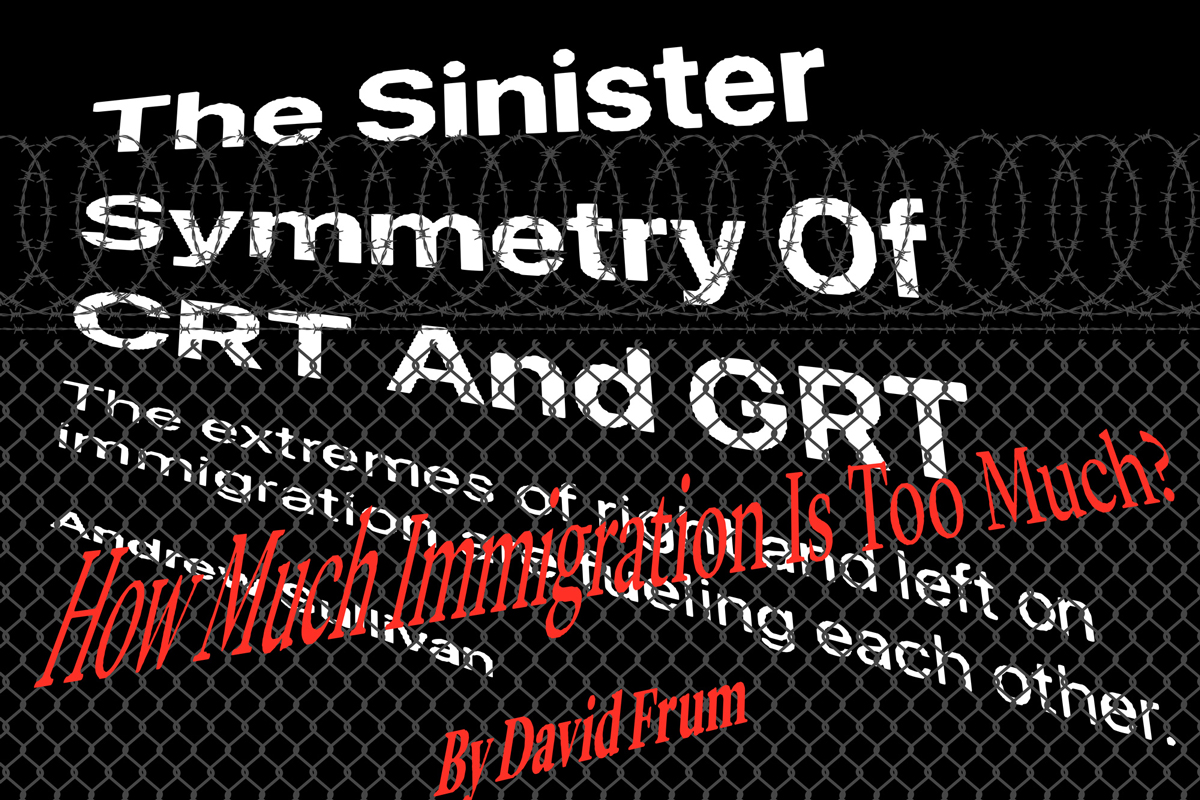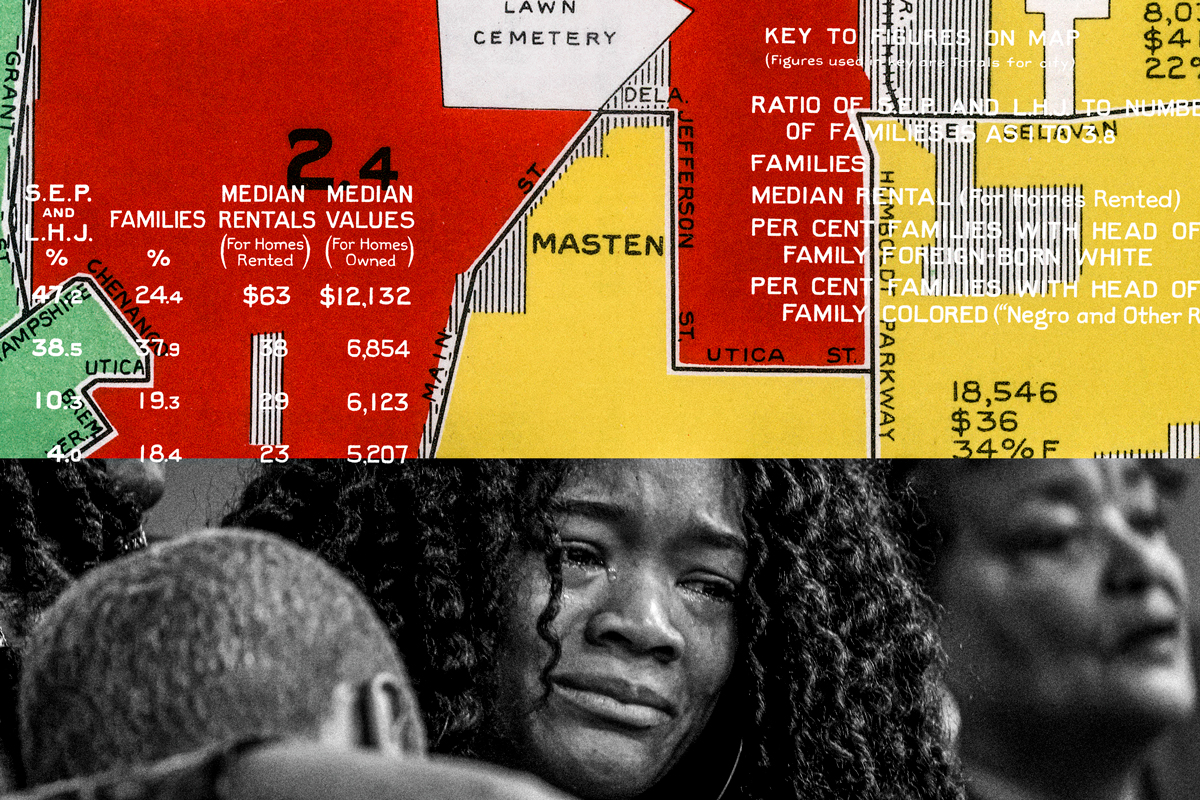What defined the Buffalo massacre, in the flow of American horrors, was how easy the attack was to define. Just as the Uvalde school shooting was a direct reprise of Sandy Hook, the Buffalo killings did not really need any time or extra explanation to find its place in public consciousness: a white teen had evidently sought out and massacred Black people who were peaceably going about their business, just like in Charleston seven years ago. The accused killer had gunned down customers in a beloved neighborhood supermarket, just like in Boulder’s mass shooting last year (right down to the death count of 10). The slaughter was accompanied by a manifesto on white demographic grievance, just like in El Paso and Pittsburgh. (Parts of the text were, in fact, reportedly plagiarized from the writing of the mass killer at a Christchurch, New Zealand mosque.)
During the years those components of racialized mass terror had all emerged and recombined, on their way to the Tops supermarket in Buffalo, they had also fully embedded themselves in the mainstream—not just by analogy or implication, but by name. The Buffalo manifesto complained about the “Great Replacement,” a term that had made its way, with the help of Tucker Carlson, from French reactionaries to American white nationalist message boards to the prime-time audience of Fox News.
The notion that white people are losing America to an influx of foreigners is not only an everyday message of Republican politics—expressed by sitting members of Congress, and by presidential aspirants long predating Donald Trump—but also an essential theme of establishment political journalism. Centrists and respectable conservatives generally prefer to attribute this feeling to the masses, rather than avowing belief in it personally, but they nonetheless treat it as something legitimate and valid, grounded in reality. Three years before the killings in Buffalo, and the same month as Christchurch, the Atlantic dedicated its cover to David Frum, who argued that “If liberals insist that only fascists will enforce borders, then voters will hire fascists to do the job liberals refuse to do.”
Frum wrote:
Without immigration restrictions, there are no national borders. Without national borders, there are no nation-states. Without nation-states, there are no electorates. Without electorates, there is no democracy.
Or, to shorten the chain of specious reasoning here: without immigration restrictions, there is no democracy. Or even more simply—given that the Atlantic was offering this warning to a country that did and does, in fact, have plenty of restrictions on immigration—immigrants are a threat to democracy.
If white Americans’ fears and resentments are justified, where does that leave the pundits when the shooting starts?
If white Americans’ fears and resentments are justified, though, where does that leave the pundits when the shooting starts? Only the most shameless, including Tucker Carlson himself, dared to argue that the Buffalo manifesto’s Great Replacement had no connection to the Great Replacement discussed on Tucker Carlson Tonight. Instead, given the now-mainstream banality of the shooter’s complaints about the imperiled white birthright of America’s proper caste of leaders and owners, the easiest move was simply to fit the whole incident into a pre-existing argument—to say that the manifesto was even more mainstream than it appeared, and that the whole idea of the Great Replacement could just as easily be traced to the left.
“[T]he uncomfortable truth is that a less conspiratorial cousin of [replacement theory] has long been embraced in mainstream public discourse,” Yascha Mounk, whose professional niche is to identify as a liberal while scolding the left for offending the center and right, told CNN in an interview. “In fact, it is one of the few things that both liberals and conservatives, both Democrats and Republicans, can now agree on.”
It was, Mounk said, the “most dangerous idea in American politics.” By this he meant not the shooter’s specific belief that a Jewish cabal was trying to seize control of America and eliminate the white race, nor even precisely Tucker Carlson’s and GOP Rep. Elise Stefanik’s claim that Democrats are opening the borders to flood the electorate with immigrants. No, Mounk was citing the general idea that the white population of the United States is on its way to becoming a plurality, rather than an outright majority—a development that is alleged most likely to benefit the Democratic Party (even though earlier forecasts of this demographic transformation have very decisively failed to come to pass).
Online pundit Andrew Sullivan has adopted the same line, with even less restraint. The media account of the shooter’s manifesto, Sullivan wrote, describes a conspiracy in which the “goal is a minority-majority country in which the Republican Party is doomed by inexorable racial demographics, and a whole new multiracial society can be built on the smoldering ruins of ‘white supremacy.’” Yet expressions of that same goal, he wrote, have been uttered by “Joe Biden, Univision founder Jorge Ramos, and sassy Dem Party hack James Carville celebrating the implosion of white America.”
Had they, though? The core of Sullivan’s argument was that, as his headline put it, there is a “sinister symmetry” between the Great Replacement Theory and Critical Race Theory. In the process of shoving the likes of Carville—lately seen on TV ranting in Sullivanesque style about how the Democrats are ruinously captive to “wokeness”—into some undifferentiable heap of pernicious leftist race radicals, Sullivan backed his rhetorical bulldozer over a whole bunch of other distinctions: the distinction between the Republican Party losing elections, for instance, and “the implosion of white America.”
From Sullivan’s point of view, the Democrats are always the party who are guilty of trampling that distinction. Democratic leaders and strategists, he argued, have been “racializing politics so aggressively that you actually help create and legitimize a racially white party—because of negative partisanship.” The Republicans, who assembled an 88 percent white voting bloc behind Mitt Romney’s presidential bid back when Ibram X. Kendi was still a junior professor at SUNY, were simply provoked into embracing “racial consciousness,” because the other races did it first.
This account of things may be wildly ahistorical, but the relevant history is what Republicans now count as Critical Race Theory. The simple act of citing CRT now effectively confirms, to the right, the justice of the backlash in all its blunt and baroque variations, from gag rules and book bans to paranoid conspiracy-mongering. So Sullivan, who has spent decades cultivating his incuriosity to the level of a superpower in the name of faux-liberal heterodoxy, proceeded to create his own definition of the problem:
A liberalism that believes that racial identity is the core identity for an American, that “whiteness” is a definable American characteristic that needs to be “dismantled,” and that the central political struggle in the US is between older whites and younger non-whites, is a liberalism helpless in the face of white nationalism.
A less impenetrable intellect than Sullivan’s might have noticed the word “white” in “white nationalism,” and started to wonder if this could all really be the doing of wokeness run amok. And a more observant commentator might have pondered the implications of naming Joe Biden and James Carville as avatars for the struggle of younger non-whites against older whites: if Democrats like Biden, in Sullivan’s account, “view a multi-racial society as a zero-sum endeavor in which a gain for whites always means a loss for non-whites,” then why are they participating in a multiracial political coalition?
American society is already nonwhite—nonwhite people are Americans, and their Americanness is not something for white Americans to negotiate for or against among themselves.
The answer is, in a clear and direct sense, unimaginable to Sullivan, in the same way that it was unimaginable to Frum and his editors at the Atlantic. It is that American society is already nonwhite—that nonwhite people areAmericans, and their Americanness is not something for white Americans to negotiate for or against among themselves.
Sullivan is aware, on some levels, that nonwhite people exist. He has burnt away large chunks of his reputation through the years by insistently trying to promote, and ignoring the methodical disproofs of, various claims that Black people fare materially worse than white people in this country because they possess some inborn inferiority. He has warned gravely in print about what it means that immigrants and foreigners are so visible today in the former Roman colonial capital of Londinium—declaring that to “those whose self-understanding is wrapped up in bluebells and tea, in English accents divided solely by class and region, in a nearly all-white and all-English country for centuries, these times are culturally terrifying.”
He has extended the same warning—“We have been fools on mass immigration, we have been fools for preventing an honest debate about the benefits and drawbacks of diversity”—to the United States, to which he himself immigrated, and from which he avoided deportation, despite being caught violating the drug laws duly passed by the citizens of this country. The real immigrants, the immigrants with drawbacks, are always somebody else—just as Black Americans are always somehow to be understood as lesser than.
This is what makes it possible to see existing Americans as “replacements,” and to pretend that Great Replacement Theory is about the future, rather than the present. In his response to the Buffalo murders, Sullivan rebuffed the idea that any cabal was deliberately trying to drown America in newcomers; instead, he argued that “a massive predictive error” by the authors of the country’s 1965 immigration reforms brought in an unexpected wave of non-European immigrants:
[B]y 2018, 78 percent of immigrants were non-European, and Europeans made up a mere 9.8 percent of new green-card holders in 2020. As for Bobby Kennedy’s prediction of 5,000 immigrants from Asia, the number now is 14 million.
Yes, and? The 1965 reforms happened more than half a century ago. Seventy percent of Americans alive today were born in the era when the nation welcomed, or at least no longer rigorously excluded, immigrants from regions other than Europe. Many of them are the children and grandchildren of those immigrants. More than 40 million people in the country today are immigrants themselves.
Pundits like Sullivan can see those numbers, but they can’t carry them over the conceptual boundary between Us and Them. He quoted the New York Times columnist Michelle Goldberg, disapprovingly: “‘Right now America is tearing itself apart as an embittered white conservative minority clings to power, terrified at being swamped by a new multiracial polyglot majority’— and she ‘felt good’ about that non-white future.” Again, his synonyms gave him away. A “multiracial polyglot majority” defeating a “white conservative minority” is identical to a “non-white future.” There is no place in a multiracial, majoritarian society for white people, as Sullivan envisions white people. So what, then, makes that vision worth defending?
Tom Scocca is the editor of Indignity.



